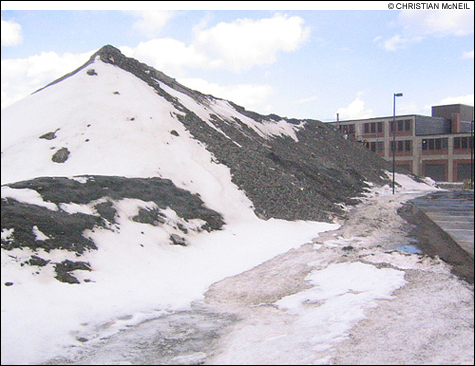
SIGHTING THE TOP: Summit a pile of frozen pollution. |
Climb the glacier
Before theBayside glacier melts away for one more season — and possibly its last — it’s worth a visit. You can climb the glacier yourself, although at your own risk (it is icy). As much garbage as there is in the glacier, for now it’s still mostly snow, and walking on top of it is no more unsanitary than walking along the curb of the average city street. The easiest route of ascent begins from the corner of Chestnut and Somerset streets, following the tread tracks of the bulldozer that shapes the glacier after every storm. If you climb on a warm day, the trickiest part will be leaping from the street onto the ice without getting your shoes lost in the thick mud at the glacier’s melting edge. From there, it’s a gradual, half-block ascent to the summit. From the top, you can look down the steep western slope and study the geological layers: near the bottom third is a leaf-strewn layer, a reminder of how the first snowstorms struck before street-cleaning crews had a chance to sweep up the autumn’s fallen leaves. Just above that is a small ridge — the January thaw, when the glacier briefly retreated. Above that are two or three additional layers, interspersed with smaller ridges associated with other rain storms and warm spells. And on the surface of the glacier is an impressive, and growing, layer of grime, the stuff that we walk though on our city streets and inhale into our lungs (albeit in smaller doses) every day.
_CM |
You’ve probably seen the Bayside Glacier: it’s that pile of dirty snow and ice that rises each winter to rival the redeveloping neighborhood’s new office buildings in bulk and height. Its summit peeks over the shorter warehouses and retail strips surrounding it, and is visible from Deering Oaks, downtown office buildings, and long stretches of I-295. Looking west from Munjoy Hill on a clear day, the dirty glacier a few blocks away looks almost as big as New Hampshire’s distant Presidential Range.The city maintains an even more massive glacier on outer Congress Street, though that one is hidden in the woods near the Sable Oaks Golf Club. Viewed as simple piles of snow, they’re spectacular enough. But they’re more powerful and enduring than any snowbank. Just as the glaciers of the ice ages scraped away Arctic rocks to deposit them in eskers and drumlins throughout Maine, Portland’s glaciers have accumulated a layered history of the city’s pollution, as the city scrapes away snow and grime from the streets and redeposits them on these empty lots.
In warmer months, all that junk washes down Portland’s storm drains and into the sewer system. But when it’s cold, snow-removal crews end up collecting the city’s effluvia and storing it above ground, for all to see. Understanding what’s inside the city’s glaciers, as they sit and melt away in Bayside and on outer Congress, is a good way to understand the kind of pollution — and how much of it — we send into Casco Bay.
Heading to the ocean
The glaciers are an annual project of Portland’s Department of Public Works (DPW). After every major snowstorm, DPW bans parking and cruises the city streets with a slow-moving convoy of dump trucks and a gigantic snowblower, relocating entire snowbanks into the empty beds of the waiting trucks. The trucks then drive the snow to the city’s designated “snow dumps” — Portland’s glaciers — and return empty for another load.
According to Steve Early, who oversees winter operations for the DPW, most of the snow collected from city streets gets delivered to outer Congress Street. But when crews working downtown need to make the most of the constrained timeframe of an overnight parking ban, the auxiliary lot in Bayside lets them avoid the longer trip to the edge of the city.
The Bayside glacier, ranging from eight to 40 feet high on a one-acre lot, contains roughly 700,000 cubic feet of snow. Early estimates that the Congress Street glacier is about 10 times more massive: millions of cubic feet of snow delivered in thousands of dump-truck loads.
In addition to snow, Portland’s glaciers contain a lot of food wrappers, especially fast-food garbage, that have been thrown from car windows or plucked from trash cans by marauding seagulls. There are also the spilled contents of recycling bins, and entire garbage bags that were perched precariously on the snowbank when a storm coincided with trash collection. There is a remarkable amount of dog shit, and the occasional forgotten snow shovel.
In short, almost anything that’s buried in Portland’s snowbanks subsequently gets chewed up by the giant snowblower and trucked to a glacier where it sits buried in ice until spring.